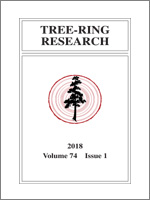We present the microscopic analysis of growth-ring boundary anatomy of 27 tree species from a moist tropical forest in Bangladesh and evaluate their dendrochronological potential. We observed high inter-species variability in the anatomical features that define growth-ring boundaries. Marginal parenchyma, fibre zones, and thick-walled latewood fibres were identified as the dominant anatomical features delineating growth-ring boundaries. The evaluation of growth-ring boundary distinctness in thin-sections and scanned images revealed that 25 out of 27 studied species (93%) showed distinct to fairly distinct growth-ring boundaries. Cluster analysis of wood anatomical features was used to select an additional 5 species for further investigation. Ring-width series of these species crossdated well within the same tree. Between trees crossdating was also successful in all 5 species. The Gleichläufigkeit (GLK; i.e. the proportion of agreement/disagreement of inter-annual growth tendencies among the trees) varied among species between 0.55 and 0.71. A strong synchronization of tree-ring series between trees suggests that growth rings are annual and influenced by common environmental factors. The derived tree-ring series, estimated tree ages, and growth trajectories underline the high potential of our study area for answering a variety of climatological, ecological and archaeological questions by applying dendrochronology. This study will therefore provide a new endeavor in tropical dendrochronology of South Asian moist tropical forests.
How to translate text using browser tools
1 January 2018
Growth-Ring Boundary Anatomy and Dendrochronological Potential in a Moist Tropical Forest in Northeastern Bangladesh
Mahmuda Islam,
Mizanur Rahman,
Achim Bräuning
ACCESS THE FULL ARTICLE

Tree-Ring Research
Vol. 74 • No. 1
January 2018
Vol. 74 • No. 1
January 2018
Bangladesh
boundary distinctness
dendrochronological potential
Growth trajectory
growth-ring boundary
moist tropical forest
tree ages




